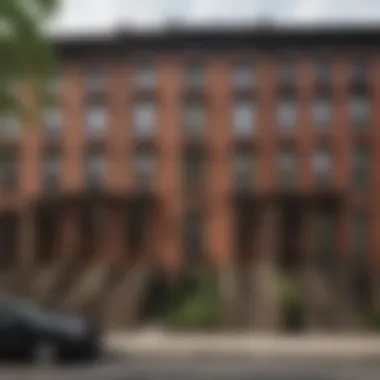Exploring Harlem's Iconic Brownstone Houses


Intro
Brownstone houses, the storied symbols of Harlem, embody both architectural elegance and a rich historical narrative. From their unique construction to their vibrant cultural significance, these structures tell a compelling story of a community shaped by social changes. While walking through the tree-lined streets of Harlem, one cannot help but be drawn to the distinct rows of brownstones that have witnessed countless transformations. This exploration will delve into the architectural inspiration behind these houses, the ongoing trends in interior design, and the broader cultural implications of their presence in the neighborhood.
Architectural Inspiration
Overview of Design Styles
The brownstone houses in Harlem are notable examples of the Romanesque Revival style, popular in the late 19th century. Characterized by their robust brickwork and distinctive brownstone facades, these houses often feature elaborate cornices, visually striking bay windows, and ornate door frames that echo the craftsmanship of that period. The influence of Gothic elements is evident in some structures through pointed arches and intricate detailing, creating an impressive architectural unity throughout the neighborhood.
Many brownstones incorporate Italianate elements as well, especially in their archways and window designs. These styles not only enhance the aesthetic appeal but also reflect the socio-economic aspirations of their original owners. Such architectural choices served to distinguish these buildings from surrounding structures and contribute to a broader identity for Harlem itself.
Innovative Materials and Techniques
The construction of brownstones utilized locally sourced materials that defined their character. The reddish-brown sandstone was quarried from nearby regions, providing durability and an aesthetically pleasing appearance. Advances in masonry and stone cutting during the 19th century allowed artisans to create intricate details that have withstood the test of time.
Today, renovation efforts focus on preserving these historic elements while integrating modern facilities. Techniques such as energy-efficient retrofits and the use of sustainable materials are now common, merging historical integrity with contemporary comfort.
"Brownstone houses are more than just homes; they are architectural statements that encapsulate the evolution of Harlem as a community."
Interior Design Trends
Color Schemes and Their Psychological Effects
Interior design in Harlem's brownstones showcases a blend of historical reverence and modern sensibilities. Color schemes chosen for these homes often draw from natural palettes, featuring earthy tones that harmonize with the exterior. Such colors not only promote tranquility but also reflect the organic warmth of the wood and stone materials used throughout.
Mood can be significantly influenced through careful consideration of colors. For instance, soft blues and greens have calming effects, making spaces feel more open and inviting. Accent colors in furniture and decor can bring vibrancy, creating a juxtaposition that highlights the architectural charm of the brownston e.
Space Optimization Tips
Given the size constraints often found in urban brownstones, effective space optimization becomes crucial. Open floor plans have gained popularity, allowing for a more fluid use of space, connecting living and dining areas seamlessly.
Additionally, creative storage solutions are vital. Built-in shelving and multi-functional furniture can enhance usability while maintaining the historical style of the home. Effective lighting, both natural and artificial, plays a key role in expanding perceived space, making interiors feel more airy and expansive.
As we continue to explore the intersection of architecture and culture in Harlem's brownstone houses, it becomes evident that these structures are more than just buildings; they are testimonies to a rich history and a vibrant community that continues to evolve.
Prelude to Brownstone Houses
Brownstone houses are more than mere structures; they are reflections of a unique blend of architecture and culture. This section aims to emphasize the significance of brownstones in Harlem, providing context not just about their physical form, but also the role they have played in shaping community and identity.
The appeal of brownstones lies in their rich history and the stories they tell about the people who have lived within their walls. From the intricate design elements to the cultural practices that occur in and around them, each brownstone embodies a particular moment in the neighborhood’s evolution. This narrative unveils layers of meaning behind these iconic buildings, drawing connection to Harlem's vibrant past as well as its ongoing transformation.
Defining Brownstone Architecture
Brownstone architecture is characterized primarily by its distinctive brown sandstone facade. This material, which comprises a variety of minerals, offers both durability and aesthetic appeal. Typically, these houses are three to four stories tall, featuring row house designs that form cohesive streetscapes. The architectural style often includes wide front steps, stoops, and ornate cornices.
In terms of layout, brownstone interiors are often spacious, promoting a family-centric environment. The parlor floors usually feature high ceilings and large windows, allowing ample natural light. Such elements foster social interaction and community engagement, which are critical aspects of Harlem life.
Origins of Brownstone Construction
The construction of brownstone houses emerged in the mid-19th century amidst New York City’s urban expansion. Initially designed for the growing middle class, these homes became especially prominent during the 1860s through the 1890s. The material itself, retrieved from quarries in the northeast United States, made it a practical choice for builders.
As urban development surged, brownstones began to symbolize success and a desirable lifestyle. Wealthy families occupied these homes, contributing to the diverse socioeconomic tapestry of Harlem. Over time, the design and construction techniques evolved, reflecting changes in architectural tastes and the social fabric of the area. Thus, understanding the origins of brownstone construction provides insight not only into the architectural journey but also into the historical significance they bear in the cultural landscape of Harlem.
Historical Context of Harlem
Understanding the historical context of Harlem is crucial to appreciate the brownstone houses that dot its streets. This section provides a backdrop against which the architectural and cultural significance of these structures becomes evident. It positions Harlem not just as a locale, but as a vibrant tapestry woven from diverse stories, struggles, and triumphs. Each brownstone stands as a testament to the neighborhood's evolution, reflecting broader societal changes and community resilience.
The Rise of Harlem in the 19th Century
The 19th century was a pivotal era for Harlem, shaping its identity and fostering its development into a major urban center. Originally, Harlem was a Dutch settlement, known for its rural charm. However, by the mid-1800s, the area began to transform. A wave of urbanization swept through New York City, making Harlem an attractive destination for both affluent families and working-class communities.
As transportation improved with the introduction of horse-drawn streetcars, more people began to settle in the neighborhood. This influx of residents led to the construction of numerous brownstone buildings. These brownstones, characterized by their distinctive brown sandstone facade, were popular for their spacious layouts and proximity to parks, making them ideal family homes.


Key factors that contributed to Harlem's rise include:
- Accessibility: The expansion of the subway system in the early 1900s further connected Harlem to Manhattan, increasing its appeal.
- Economic Opportunities: As the economy grew, so did job prospects, attracting workers to the area.
- Real Estate Development: The demand for housing led to rapid construction, resulting in a significant number of brownstone residences.
With each passing year, the neighborhood blossomed, laying the groundwork for its cultural landscape.
Impact of the Great Migration
The Great Migration marked a significant turning point in Harlem's history, dramatically altering its demographic landscape. Between approximately 1916 and 1970, millions of African Americans left the rural South in search of better opportunities in Northern cities. Harlem became a focal point for this migration, becoming a cultural haven for newly arrived residents seeking community and connection.
This migration had profound impacts, including:
- Cultural Flourishing: Harlem became synonymous with the Harlem Renaissance, a period of prolific artistic and literary output that celebrated African American culture. Icons like Langston Hughes and Zora Neale Hurston found inspiration in the neighborhood's vibrant scene.
- Economic Growth: New businesses emerged, catering to the needs of the growing population, which added to Harlem’s economic vitality.
- Social Change: The influx of people brought diverse ideas on civil rights and social justice, influencing activism within the community.
Harlem transformed into a crucible of culture, creativity, and political awakening during this period. Its brownstones, once mere residences, became vital to the fabric of African American heritage.
Architectural Features of Brownstones
Understanding the architectural features of brownstones is crucial for appreciating their historical significance and aesthetic appeal. These structures, characterized by their unique design elements, not only reflect a specific architectural style but also have played a vital role in shaping Harlem's community identity. Through an exploration of common design elements and variations in style, one can gain insights into the broader cultural narratives that these houses embody.
Common Design Elements
Brownstones typically present a cohesive range of design features that set them apart from other residential buildings. The most recognizable element is the brownstone facade, made from brown sandstone. This material gives the buildings their warm, inviting appearance and durability.
Other notable design elements include:
- Stoop access: Most brownstones include a small staircase leading to the front door, known as a stoop. This feature promotes social interaction and neighborly connections by encouraging residents to sit outside and engage with the community.
- Large windows: Brownstones often have expansive windows, allowing for ample natural light. This design choice enhances the interior atmosphere and reflects a style that values brightness and openness.
- Ornate cornices and moldings: Detailing in the cornices and moldings adds visual richness, showcasing the craftsmanship of the era. Each brownstone often exhibits unique carved elements that tell a story about its construction and design philosophy.
Such elements are not merely decorative but also serve functional purposes, showcasing how aesthetic considerations can influence practicality in architecture.
Variations in Style and Layout
While brownstones generally share common characteristics, there are significant variations that reflect individual preferences and local influences. These differences can be particularly seen in the layout and overall design.
For instance:
- Rowhouse vs. standalone brownstones: Some brownstones are part of a uniform row, which creates a harmonious streetscape. Others stand alone, which can highlight their unique design features.
- Interior layouts: The interior spaces of brownstones can markedly differ. Some have traditional layouts with formal living and dining rooms, while others have adopted more modern, open-concept designs. This reflects evolving lifestyle preferences.
- Architectural styles: While many brownstones showcase a Renaissance Revival style, others incorporate elements of Neo-Classical or Romanesque architecture. These stylistic variations can be traced back to different time periods and influences during their construction.
"Brownstones are more than just structures; they encapsulate the social and cultural revolutions that have swept through Harlem over the decades."
In summary, the architectural features of brownstones illustrate a rich tapestry of historical context and aesthetic value. The interplay of common elements and unique variations not only enhances the visual landscape of Harlem but also reinforces the community bonds established over generations.
Cultural Significance of Brownstones
Brownstone houses hold more than just architectural weight in Harlem. They are symbols of resilience, community, and cultural legacy. Their significance extends deeply into the fabric of Harlem’s history and its evolution, representing a myriad of narratives spanning past and present.
Individuals who inhabit these brownstones are not merely home residents; they are part of a longer story. Each brownstone retains memories of its past, embodying the lives that have flourished within its walls. This architectural style narrates the aspirations and struggles faced by its communities. It is through understanding this deeper meaning that one appreciates how brownstones contribute to Harlem's cultural landscape.
Brownstones as Cultural Symbols
Brownstones have become icons of status and culture among African American communities. They signify a level of achievement, especially during periods when homeownership was a challenging endeavor for many. For many, owning a brownstone represents an aspirational journey toward stability and success. The cultural identity of Harlem is intertwined with the existence of these homes. In a way, each brick can tell stories of triumph and resilience against overwhelming odds.
As much as they symbolize individual success, brownstones also reflect collective memory. They serve as vibrant platforms for countless community events, gatherings, and artistic expressions. With this rich history, these structures have become integral in shaping Harlem's unique cultural heritage, from jazz performances to literary readings.
Art and Literature Inspired by Harlem
Harlem has long served as a muse for writers, artists, and musicians, thanks to its rich cultural backdrop. Many significant artistic movements have stemmed from the neighborhood, highlighted by the Harlem Renaissance in the early 20th century. Writers like Langston Hughes and Zora Neale Hurston drew inspiration from their surroundings, with brownstones frequently referenced in their works. These literary figures depicted both the beauty and complexities of life within Harlem, forever linking the neighborhood with its brownstone architecture.
Art and performance are interwoven deeply with the history of Harlem. Visual artists, from Jacob Lawrence to Romare Bearden, depicted the vibrancy of life in the brownstones. Their works showcase not just the buildings but also the dynamic communities within them. This cultural symbiosis paints a picture of Harlem as a wellspring of creativity, underlining how brownstones serve as both homes and cultural canvases.
"The lifeblood of Harlem flows through its brownstones, where art meets life, and history melds with culture."
In summary, the cultural significance of brownstones in Harlem cannot be overstated. They are not mere buildings, but testaments to the enduring spirit of a community that continues to inspire future generations.


Preservation of Brownstone Heritage
The preservation of brownstone heritage is essential for maintaining the identity of Harlem and its architectural landscape. These unique buildings reflect the history and culture of the community. Brownstones have withstood the test of time, representing resilience in the face of urban changes. By preserving these structures, we protect the narratives embedded within their walls.
The benefits of preserving brownstones extend beyond aesthetics. They contribute to the economic vitality of neighborhoods by attracting tourism. Many visitors are drawn to Harlem for its rich history and culture, and brownstone houses often serve as focal points for tours and exploration. Additionally, preserved brownstones tend to increase property values within their vicinity, supporting local economies. Furthermore, they provide insight into the architectural styles that shaped the cityscape, offering educational opportunities for all.
However, preservation efforts must carefully consider materials and architectural elements to maintain historical accuracy. Balancing modern needs with historical integrity is a constant challenge for homeowners and preservationists alike.
Challenges in Preservation Efforts
The journey of preserving brownstone heritage involves several challenges. A major issue is financial constraints. Restoration can be expensive due to the cost of high-quality materials and skilled labor. Many homeowners may find it difficult to invest in maintaining the historical components of their houses while also managing modern living necessities.
Another challenge is compliance with local regulations. Depending on the area, homeowners may face strict guidelines that dictate how renovations can occur. This can create friction between maintaining original design and meeting modern safety and livability standards. Additionally, some brownstones suffer from neglect, leading to deterioration. Reviving these homes requires not only financial investment but also time and community support.
Lastly, changes in property ownership can affect preservation efforts. New owners may prioritize different upgrades, ignoring the unique aspects that characterize brownstone architecture. This inconsistency poses a risk to the uniformity and cultural significance that these buildings represent.
Success Stories in Restoration
Despite the challenges, there are numerous success stories in the restoration of brownstones in Harlem. Some homeowners have undertaken ambitious projects that breathe new life into neglected properties.
- One notable case involves a group of neighbors who banded together to restore a block of brownstones. They shared resources and expertise, cultivating not just homes but a connected community.
- Another inspiring example is the renovation of the historic A’Lelia Walker House. This landmark not only preserves architectural history but also serves as a cultural center focused on the arts.
- The Harlem Renaissance-inspired designs have been reflected in various brownstone restorations, emphasizing the neighborhood's rich cultural heritage. These efforts showcase strong community engagement and a commitment to preserving history, inspiring others to consider the importance of maintaining Harlem's architecture.
In summary, while the preservation of brownstone heritage comes with challenges, the success stories remind us of the potential that exists when communities unite to celebrate and protect their history.
Current Trends in Brownstone Ownership
Brownstone ownership in Harlem reflects much about contemporary urban living. The charm of these historic homes, combined with modern desires for space and community, shapes the dynamics of property ownership in the area. This segment is crucial as it captures how socio-economic elements influence the appeal and pricing of brownstones, ultimately affecting the fabric of local community life.
Market Dynamics and Pricing Trends
The market for Harlem's brownstone houses is experiencing notable shifts. Over the past decade, real estate values in this neighborhood have seen substantial increases. Brownstones that once sat on the market for an extended period now attract interest from various buyers, especially young professionals and families seeking more space in a vibrant cultural setting.
Factors influencing pricing include:
- Location: Proximity to transportation and amenities plays a significant role. Properties closer to major subway lines or popular districts tend to command higher prices.
- Condition of the Property: Homes that have been well-maintained or recently renovated see higher demand. Conversely, those needing extensive repairs may remain stagnant on the market.
- Broader Economic Trends: Fluctuations in the economy, interest rates, and housing supply also impact overall pricing trends. Buyers are increasingly looking for investment opportunities, considering brownstones as both homes and revenue-generating properties via rentals.
As more buyers enter this competitive arena, it results in a gradual shift towards a seller's market. Increased bidding wars and off-market deals are becoming common.
Demographics of Current Homeowners
The demographic landscape of current brownstone homeowners is diverse. There is a noticeable trend towards younger homeowners, along with significant representation from various cultural and ethnic backgrounds. This shift brings a unique blend of ideas and aspirations to the community.
Key demographic trends include:
- Age Range: A large proportion of buyers are in their 30s and 40s. Many are professionals looking to establish roots in neighborhoods with a rich history.
- Income Levels: Households with higher incomes are increasingly seeking brownstone homes, driven by the desire for larger living spaces compared to Manhattan apartments.
- Cultural Diversity: The demographic shifts reflect Harlem's historic status as a cultural melting pot. This diversity enriches the community, contributing to a vibrant social fabric that resonates throughout the neighborhood.
"The people who inhabit these homes now are not just residents; they are part of a narrative that continues to evolve."
In summary, current trends in brownstone ownership in Harlem underscore the intersections of history, culture, and real estate economics. As the appeal of these homes continues to grow, understanding the market dynamics and homeowner demographics remains vital for anyone interested in the unique landscape of Harlem real estate.
Renovation Trends in Harlem Brownstones
Renovation trends in Harlem's brownstones are vital to understanding how owners balance modern needs with the historical significance of these homes. As Harlem evolves, the role of renovation becomes increasingly important. Homeowners seek to optimize living spaces while preserving the unique character of brownstones. This section outlines key aspects of current renovation trends, focusing on specific elements, benefits, and considerations.
Modern Upgrades versus Historical Integrity
The challenge of integrating modern upgrades into historic brownstones centers around the delicate balance of maintaining historical integrity. Homeowners often desire open floor plans, improved energy efficiency, and advanced technologies. However, these upgrades must not compromise the architectural heritage of the brownstone.
For instance, replacing old windows with energy-efficient models presents a dilemma. Some owners choose to restore original windows while adding storm windows for better insulation. This method provides energy efficiency without sacrificing aesthetic value.
Another common upgrade involves kitchen renovations. Many owners modernize kitchens without altering key elements such as molding or fixtures. This approach preserves the home's character while enhancing functionality. It is crucial for homeowners to engage with preservation experts during renovations to navigate complex requirements that protect the historical nature of these structures.
"Balancing modern needs with historical features is a challenge for every brownstone owner. The goal is to respect the past while embracing the future."


Sustainable Practices in Renovation
Sustainability has emerged as a core principle in renovating Harlem brownstones. As environmental concerns gain prominence, homeowners are increasingly adopting green practices. Sustainable renovations comprise various approaches, including using reclaimed materials, energy-efficient appliances, and sustainable building methods.
For example, installing solar panels may be a desirable addition to a brownstone. Homeowners often explore the potential for retrofitting solar energy systems while ensuring aesthetic considerations align with historical preservation guidelines. Additionally, many opt for eco-friendly materials and finishes, further enriching their living environment.
In summary, incorporating sustainable practices in brownstone renovations not only contributes to environmental responsibility but also enhances property value.
This ongoing evolution illustrates the adaptability of brownstones, ensuring their relevance in a continuously changing urban landscape.
Community Impact of Brownstone Living
The community impact of brownstone living in Harlem is multifaceted, encompassing social, economic, and cultural dimensions. These iconic structures not only represent a significant architectural style but also serve as a backdrop for a vibrant and evolving community. Understanding this impact reveals the ways in which brownstones shape not only the physical landscape but also the social fabric of Harlem.
Neighborhood Dynamics and Relationships
Brownstone houses often foster a strong sense of community among residents. This architectural style is typically characterized by its close quarters, with homes often built in rows or clusters. Such arrangements facilitate interactions among neighbors, creating bonds that contribute to a sense of belonging. As residents share their daily lives, they build informal networks of support, mentorship, and camaraderie.
Moreover, the architectural integrity of brownstones encourages residents to maintain their properties in a manner that reflects pride in their neighborhood. This pride translates into enhanced cooperation among residents, helping to organize community events, safety initiatives, and social gatherings. These shared experiences draw people together, reinforcing collective identity and purpose.
Additionally, brownstone living allows for diverse demographics to coexist. This diversity can lead to rich cultural exchanges, where traditions and values are shared among neighbors, fostering mutual respect and understanding. Such neighborhood dynamics can counteract isolation and build a stronger, more unified community, regardless of backgrounds or circumstances.
Role of Brownstones in Local Economy
In the economic landscape of Harlem, brownstone houses play a pivotal role. Their presence elevates property values in the area, which can attract investors and potential homeowners. This gentrification can sometimes come with challenges, but it can also stimulate local business growth. New cafes, shops, and services often arise to cater to the influx of residents and tourists drawn by the charm of the brownstone architecture.
Brownstones also provide opportunities for entrepreneurship. Many homeowners choose to convert parts of their properties into rental units, thereby generating passive income. This practice not only benefits individual homeowners but also contributes to the local economy by providing affordable housing options, particularly in an urban environment where such availability can be constrained.
Furthermore, the maintenance and restoration of these historical homes create demand for skilled labor. Craftsmanship in areas such as masonry, carpentry, and interior design flourishes in response to homeowners' desire to retain the original character of their homes while upgrading them for modern living. This creates jobs and supports local tradespeople, linking residential choices directly to economic vitality.
"Brownstones serve as both homes and historical vessels, grounding the economy of the community within their walls."
Future of Brownstone Architecture in Harlem
As Harlem continues to evolve, the future of brownstone architecture remains a topic of significant interest. This section examines predicted trends in real estate and explores how community engagement influences development choices. Brownstones represent not just residential spaces, but they also encapsulate a rich history and cultural identity for many Harlem residents. Their preservation amid ongoing urban development is critical, ensuring that the unique character of the neighborhood is maintained while also accommodating modern needs.
Predicted Trends in Real Estate
The real estate landscape in Harlem is changing. Several trends are emerging that will shape the future of brownstone ownership.
- Increased Property Values: Over recent years, brownstones have seen a rise in property values. This trend is expected to continue as more people discover the charm and historical significance of these homes. Demand for brownstones particularly from buyers looking for investment properties adds to this rising trend.
- Focus on Preservation: There is growing awareness of the historical significance of brownstones. This has led homeowners to invest in preservation efforts rather than complete renovations. A balance between modern amenities and historical integrity is becoming a priority.
- Diverse Demographics: The demographic makeup of the area is shifting, with younger families and professionals increasingly interested in Harlem. This change encourages a demand for brownstones that cater to modern lifestyles without sacrificing historical aesthetics.
"The future of Harlem's architecture lies in its ability to adapt while respecting its past."
Engagement of Local Communities in Development
Local communities play a crucial role in influencing the future of brownstone architecture. Their active participation leads to thoughtful development that reflects the desires and needs of residents.
- Community Meetings and Feedback: Residents often engage in discussions about proposed changes in their neighborhoods. Input from local voices ensures that developments align with community values, fostering inclusiveness.
- Support for Local Initiatives: Many community groups advocate for the preservation of brownstones. They work alongside city planners to create initiatives that protect these structures while promoting sustainable development.
- Cultural Programming: Events and programs that celebrate Harlem's cultural heritage help strengthen the community's bond with its architecture. Through arts, festivals, and historical tours, local cultures are showcased, emphasizing the importance of brownstones in Harlem's identity.
As Harlem progresses, the future of its brownstone architecture will be shaped by a combination of market trends and the active engagement of its community members. Understanding these dynamics is essential for appreciating how Harlem maintains its vibrant character amid changing times.
The End: The Legacy of Harlem’s Brownstones
The legacy of Harlem’s brownstones extends beyond their physical presence; they are symbols of resilience, culture, and community in a rapidly changing urban landscape. These structures reflect the intricate history of Harlem, a neighborhood that has undergone significant transformations over the years. As we dive deeper into its significance, we can appreciate the architectural beauty, historical relevance, and cultural impact these homes carry.
Reflecting on Their Historical Importance
Brownstone houses in Harlem represent more than just a style of architecture; they are a testament to the neighborhood's evolution. Emerging during the 19th century, these buildings were not only homes but also reflections of the socio-economic conditions of their time. They housed immigrants and middle-class families, serving as a backdrop for numerous stories of hope and struggle. With ornate facades and spacious interiors, brownstones also embodied aspirations of prosperity.
The historical importance of these brownstones can be seen in the role they played during significant events such as the Great Migration. Many African Americans who moved to Harlem sought refuge and opportunity, finding not only a community but a cultural identity framed by these homes. The preservation of these brownstones becomes crucial, as they continue to tell the stories of those who lived and thrived within their walls.
The Ongoing Story of Brownstone Living
Today, the narrative surrounding brownstone living remains dynamic. With ongoing renovations and new families moving in, these homes are adapting to modern needs while preserving their essential character. Each renovation project engages with the balance of maintaining historical integrity while integrating contemporary life. For many, living in a brownstone means more than owning real estate; it signifies a connection to a rich heritage understood through the unique architecture and the stories of past residents.
Moreover, as Harlem continues to grow and change, brownstones contribute to community identity. They foster connections among neighbors and act as cultural anchors amidst urban development. The ongoing story of Harlem’s brownstones encapsulates both a celebration of history and a commitment to preserving it for future generations.
"Preservation of brownstones is not merely about safeguarding buildings; it is about honoring the legacy of the community that built them."







